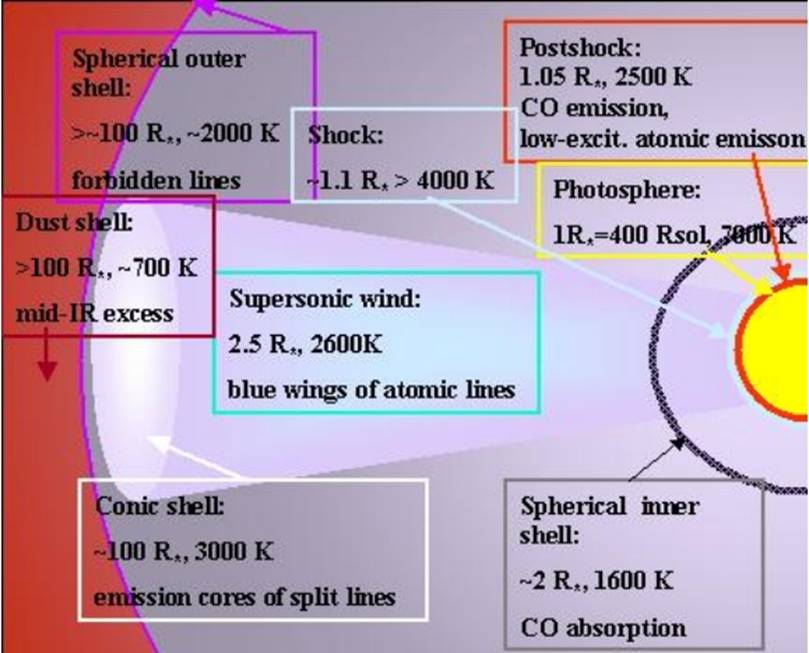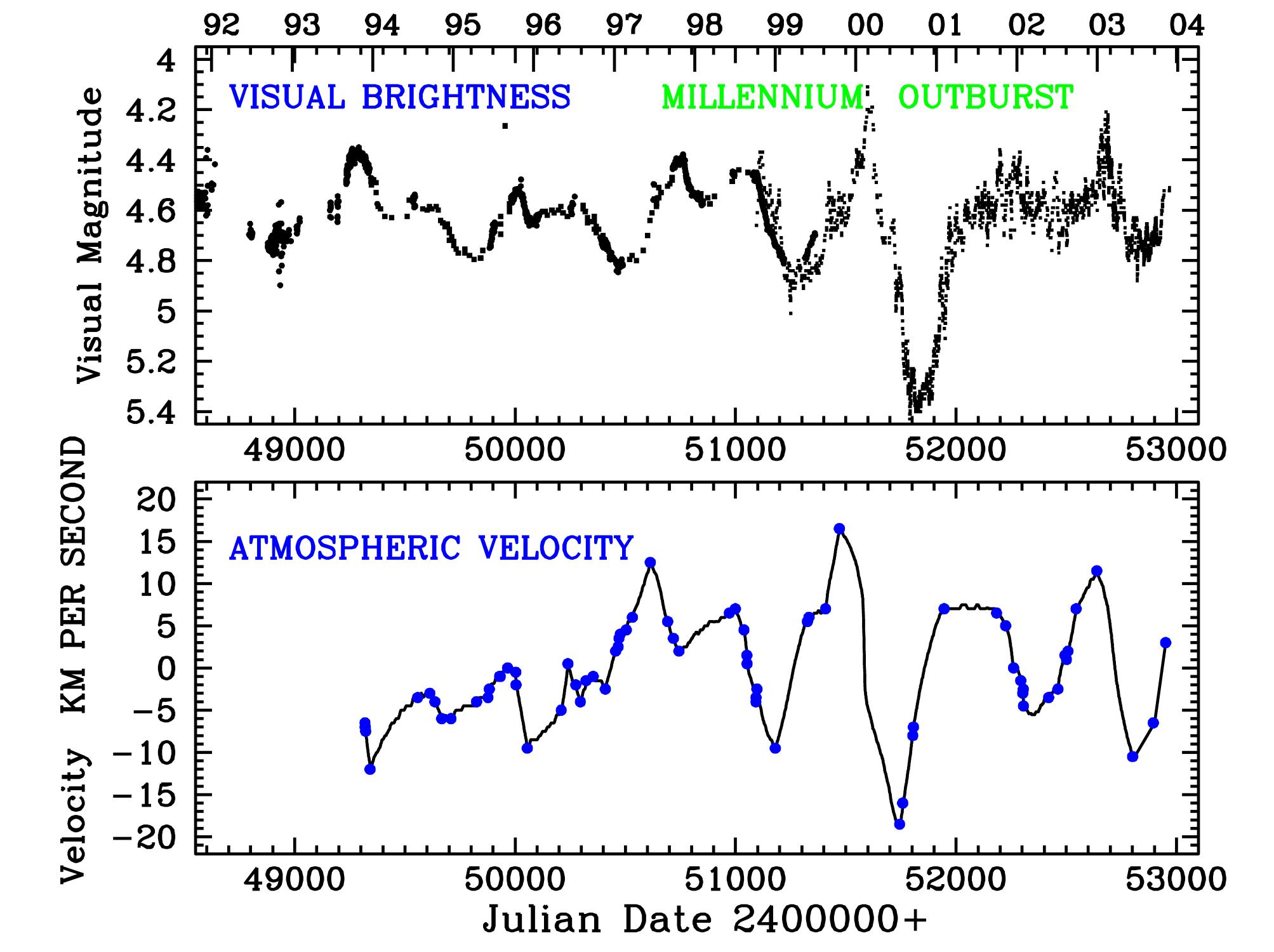Long-term Spectroscopic Monitoring of Yellow Hypergiant Rho Cas
Research
Rho Cas is a cool hypergiant, one of the most luminous cool massive stars presently known. Yellow hypergiants are post-red supergiants, rapidly evolving toward the blue supergiant phase. They are among the prime candidates for progenitors of Type II supernovae in our Galaxy. With a spectral type of F8-G2 Ia0 (Teff= 6500-7200 K), and a luminosity of log (L*/Lsun)~5.7 (R*~ 400-500 Rsun), Rho Cas is one of a small sample of known yellow hypergiants in the Galaxy. This type of massive supergiant is very important to investigate the atmospheric dynamics of cool stars and their poorly understood wind acceleration mechanisms. In quiescent variability phases the star looses mass at a rate of few 10^-4 Msun, which is intermediate for cool hypergiant stars, but can increase by two orders of magnitude during rare outburst episodes. These wind driving mechanisms are also important to study the physical causes for the luminosity limit of evolved stars. Evolutionary tracks and possible membership to the Cas OB5 association indicate a stellar mass of ~40 Msun and possible ages of 4 to 6 Myr. Observations of CNO-processed abundances in its extended Na-enriched atmosphere signal that this yellow supergiant has gone through dredge-up in the red supergiant stage, and is presently evolving bluewards. The star is about to cross the so-called atmospheric instability region in the upper HR-diagram: "the Yellow Evolutionary Void", where due to the enormous atmospheric scale height of these massive evolved stars, coupled with a large temperature in the shell-burning layers, the effective surface acceleration essentially vanishes, producing dynamically unstable stellar atmospheres.
Rho Cas is a rare bright cool hypergiant, which we are continuously monitoring with high spectral resolution for over 14 years. Its He-core burning phase is accompanied by tremendous episodic mass-loss events, which we recently observed with a new outburst between 2000 July and 2001 April. Rho Cas's atmospheric instability is manifested in both its quasi-periodic photometric behavior and unusual spectral variability. It normally pulsates semi-regularly (Srd) with P= 320-500 d, and an amplitude of +/- 0.2 (V band). Once every 20 to 50 years, however, this hypergiant goes into an outburst by dimming more than a full visual magnitude, decreasing the effective temperature by more than 3000 K, and by ejecting a massive gas shell. The most recent outburst event occurred in 2000-2001 which we carefully monitored using high-resolution optical spectroscopy.
Results
In quiescent pulsation phases Rho Cas is a luminous late F-type supergiant. During a tremendous outburst of the star in 1945-1947 strong absorption bands of titanium-oxide (TiO) suddenly appeared in its optical spectrum, together with many low excitation energy lines, not previously observed. These absorption lines, normally observed in M-type supergiants, were strongly blue-shifted, signaling the ejection of a cool circumstellar gas shell. In July 2000 we observed the formation of new TiO bands during a strong V-brightness decrease by ~1.4 mag. (see right-hand panel of Fig. 2). Our synthetic spectrum calculations show that Teff decreased by at least 3000 K, from 7250 K to ~4250 K, and the spectrum became comparable to the early M-type supergiants Mu Cep and Betelgeuse. The TiO bands reveal the formation of a cool circumstellar gas shell with a gas kinetic temperature below 4000 K due to supersonic expansion of the photosphere and upper atmosphere. We observe a shell expansion velocity of v_exp=35 +/- 2 km/s from the TiO bands. From the synthetic spectrum fits to these bands we compute an exceptionally large mass-loss rate of Mdot = 5.4 x 10^-2 Msun/y, comparable to the values estimated for the notorious outbursts of Eta Carinae .
Figure 1 shows dynamic spectra of H alpha and of Fe I 5572 observed between 1993 and late 2003. The white spots in H alpha are emission above the stellar continuum level. The radial velocity curves of the H alpha absorption line core and the photospheric Fe I line (white dashed lines) reveal a velocity stratified dynamic atmosphere. Notice the large blueshift of the Fe I lines during the outburst of mid 2000. The outburst is preceded by enhanced emission in the short wavelength wing of H alpha, while the Fe I line shifts far redwards. A strong collapse of the upper H alpha atmosphere and the lower photosphere precedes the outburst event during the pre-outburst cycle of 1999 (see the right-hand panel of Fig. 1). An animation of the line profile changes can be viewed in the caption of Fig. 1.


Figure 1: Left-hand panel: An artist's rendition of the millennium outburst of Rho Cas. In Jan. 2000 the visual brightness increases
rapidly due to the unusually strong collapse of the lower atmosphere increasing the surface temperature above 7000 K. In early and mid-2000
the atmosphere rapidly expands while the spectrum strongly shifts toward shorter wavelengths. The outer atmosphere accelerates supersonically
and is partly expelled into space by the eruption. The entire upper atmosphere begins to quickly cool, which changes the usual yellowish-white
color of the star to orange. In the summer and fall of 2000 the temperature in the outer atmosphere decreases below 4000 K. New molecules
can then form and appear in the optical spectrum. In the meantime, the lower surface starts to retreat and the spectrum shifts back toward
longer wavelengths. The cool circumstellar gas shell ejected by the explosion expands further, possibly becoming detached one year later,
while the atmosphere contracts and the hypergiant's brightness and surface temperature increase to the levels before the outburst. View animation.
Right-hand panel: Dynamic spectra of H alpha (panel left) and Fe I 5572 (panel right). The line profiles are linearly interpolated
between consecutive observation nights in the past decade, marked by the left-hand tickmarks. Notice the strong blue-shift of the Fe I line
during the outburst of mid 2000. The outburst is preceded by very strong emission (white spots) in the short-wavelength wing of H alpha, while
the absorption core extends longward, and the photospheric Fe I line strongly red-shifts. A strong collapse of the upper and lower atmosphere
precedes the outburst. Fast expansion of the upper H alpha atmosphere is also observed over the past year.
View animation.
More recently we found that very strong emission in the first overtone band of CO occurred when strong atomic emission lines were observed during the months preceeding the 2000-01 outburst. We also carefully monitored the CO band which confirmed that the prominent emission lines appear at the beginning of each pulsation cycle when the atmosphere rapidly expands, or just before the optical brightness begins to decrease. The optical atomic emission lines are proposed to originate from an interface between the fast and collimated stellar wind colliding with material previously expelled during the hypergaint's violent mass-loss history. A consistent model for CO emission line formation region can also be proposed. The variable molecular emission emerges from the cooling flow behind a pulsation-driven shock wave at relatively small distance from the stellar photosphere (see the left-hand panel of Fig. 2).


Figure 2: Left-hand panel: Diagram of the circumstellar environment of Rho Cas based on optical and IR spectroscopic features and weak IR dust emission observed with IRAS. Right-hand panel: Visual brightness variations of Rho Cas between 1993 and 2004 (upper panel) are strongly related to changes of the velocity of the atmosphere (lower panel), as inferred from the position of absorption lines in the hypergiant's optical spectrum. During the outburst of 2000, the star dimmed by about 1.3 magnitudes and the surface temperature decreased by at least 3000 K as a result of the supersonic expansion of the entire atmosphere approximately one hundred days earlier. Blue points in the lower panel indicate flow velocities in the lower atmosphere measured from an individual optical absorption line of Fe I 5572. Photometric data in upper panel are prodived by the American (AAVSO), French (AFOEV), and Japanese (VSNET) amateur observer groups.
Read more: Two Decades of Hypergiant Research PDF
Read more: Theory of Atmospheric Shock Waves
Read more: Upper Luminosty Limit of Massive Stars
Link To: AAS Press Conference of Jan. 2003: The Millennium Outburst of the Yellow Hypergiant Rho Cassiopeiae
Link To: Amateur Astronomer Observations of the Rho Cas Millennium Outburst
Link To: The Rho Cas Millennium Outburst in the Media
Selected Papers
- Lobel, A., et al. 2003, The Astrophysical Journal, 583, 923, High-Resolution Spectroscopy of the Yellow Hypergiant Rho Cassiopeiae from 1993 Through the Outburst of 2000-2001. PDF ADS
- Lobel A., Israelian G., de Jager C., Musaev F., Parker J. Wm., & Mavrogiorgou A., 1998, Astronomy & Astrophysics, 330, 659, The Spectral Variability of the Cool Hypergiant Rho Cassiopeiae. PDF ADS
- Lobel, A. 2004, Mercury Magazine, Vol. 33, No. 1, 13, Astronomical Society of the Pacific, Keep an Eye on Hypergiant Rho Cassiopeiae. Mercury Mag.
- Gorlova, N., Lobel, A., Burgasser, A. J., Rieke, G., Ilyin, I., & Stauffer, J. R. 2006, The Astrophysical Journal, 651, 1130, On the CO Near-Infrared Band and the Line-splitting Phenomenon in the Yellow Hypergiant Rho Cassiopeiae. PDF ADS